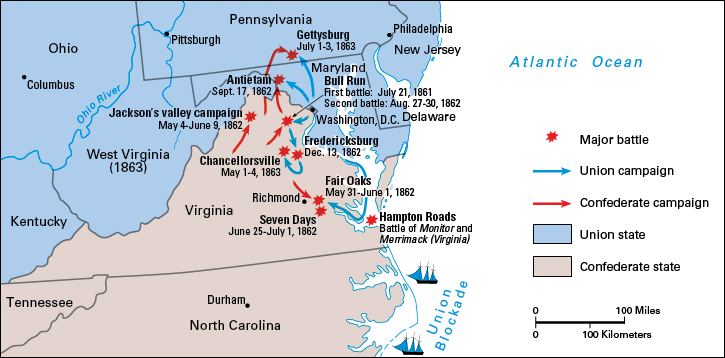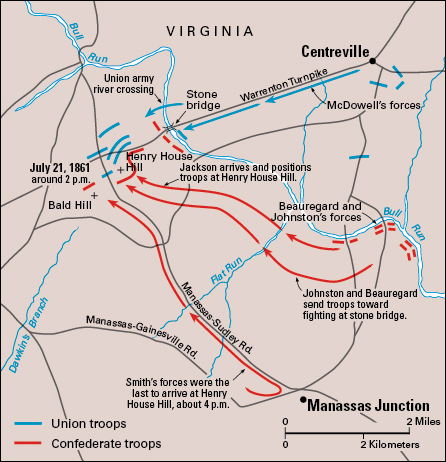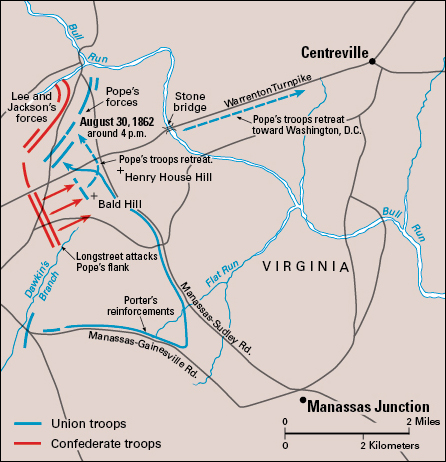Bull Run, Battles of, were two important Confederate victories in the American Civil War (1861-1865). The battles took place in northeastern Virginia in 1861 and 1862 and are named after a creek on the battlefield. They are also known as the battles of Manassas, after a town on the battlefield.
The First Battle of Bull Run
(or First Battle of Manassas) was the first major land battle of the Civil War. Confederate Generals Pierre G. T. Beauregard and Joseph E. Johnston led troops to victory against the Union army of General Irvin McDowell.

The Civil War began in April 1861, when Confederate forces under Beauregard attacked and captured Fort Sumter, a United States Army post in the harbor of Charleston, South Carolina. After the attack, President Abraham Lincoln called for volunteers to serve for 90 days to fight the Confederates. Lincoln chose McDowell to train and command the Union troops near Washington, D.C. Other commanders led Union troops elsewhere in the country.
Jefferson Davis, president of the Confederate states, deployed two armies in Virginia. Beauregard’s army was at Manassas, Virginia—between Washington, D.C., and the Confederate capital of Richmond, Virginia. The other army, led by Johnston, was responsible for holding the Shenandoah Valley in Virginia. A railroad that connected Manassas and the Shenandoah Valley could quickly move Confederate troops from one position to the other.
McDowell, believing his Union army of 35,000 would be able to overwhelm Beauregard’s force of 20,000, planned an attack. His plan called for Union General Robert Patterson to lead 18,000 troops in an effort to prevent Johnston’s army of 12,000 from helping Beauregard. On July 16, McDowell’s troops left their camps around Washington, D.C., and headed south toward Beauregard’s army. That same day, Patterson’s army advanced toward Johnston. However, Patterson mistakenly believed his troops were outnumbered, so he retreated from Johnston. This retreat allowed Johnston to send troops to Beauregard just before the battle started.

Early on the morning of July 21, McDowell’s troops left their camps and advanced toward the Confederates. McDowell ordered a portion of his army to attack the Confederates at a stone bridge that crossed Bull Run. The majority of his army marched north of the bridge, crossed Bull Run, and then turned back south to attack the flank (side) of the Confederate army.
Although the Confederates were outnumbered, they slowed the Union advance while reinforcements arrived. Most of the Confederate troops were a few miles southeast of the stone bridge, and Beauregard and Johnston sent them toward the fighting at the bridge. Eventually, though, the outnumbered Confederates retreated to high ground at nearby Henry House Hill.
At Henry House Hill, Confederate General Thomas Jackson positioned his newly arrived troops to meet the Union advance. Confederate General Barnard E. Bee, trying to rally his troops, saw Jackson’s line and shouted, “There is Jackson standing like a stone wall. Rally behind the Virginians!” From then on, Jackson was known as “Stonewall,” and his brigade as the Stonewall Brigade. However, some historians believe Bee was actually criticizing Jackson for just standing in place like a “stone wall.” Bee never had a chance to explain his comment—he died in the battle.
The Union generals reorganized their troops and launched an attack at Henry House Hill. The fighting continued for a few hours. About 4 p.m., the Confederates launched a counterattack, and the Union troops, who had been marching or fighting for most of the day, withdrew from the hill. The withdrawal turned into a rout, as panicked Union soldiers fled east toward Washington, D.C. After the battle, some Southerners regretted not pressing on in an attempt to capture the Union capital. However, most experts believe such an attempt probably would have failed.
During the course of the First Battle of Bull Run, the Union suffered about 3,000 casualties, and the Confederates about 2,000. After the battle, President Lincoln replaced McDowell with General George B. McClellan. Lincoln also called for hundreds of thousands of soldiers to sign up for three years of service. The North now realized that it faced a long fight. Many Northerners had earlier predicted that the war would be over in three months.
The Second Battle of Bull Run
(or Second Battle of Manassas) took place in August 1862, more than a year after the first battle. Confederate forces under General Robert E. Lee defeated a Union army led by General John Pope. In the battle, the Union army suffered nearly twice as many casualties as the Confederates. 
In the spring of 1862, Union General George B. McClellan sailed his army from Washington, D.C., to the peninsula between the York and James rivers in Virginia. The move marked the beginning of the war’s peninsular campaign. The Union army advanced to within 6 miles (10 kilometers) of the Confederate capital at Richmond, but Lee’s Confederate troops pushed them back. McClellan was then ordered to withdraw his army from the peninsula and unite it with Pope’s troops, who were already in northern Virginia.
Lee moved rapidly northward to attack Pope before McClellan’s men could join him. On August 25, Lee sent 24,000 troops under General Stonewall Jackson around Pope’s army. Two days later, Jackson’s troops seized a large Union supply base at Manassas. Jackson’s troops feasted on captured food, took some of the Union supplies, and then burned the rest. Pope, who commanded 65,000 troops about 25 miles (40 kilometers) southwest of Manassas, hoped to destroy Jackson’s army before the rest of Lee’s army could join it.
On August 29, Pope launched a series of small, separate attacks against Jackson’s troops. Several times during the day, Union troops came close to breaking Jackson’s line, but each time they were forced back. Late that day, Lee and General James Longstreet, with about 30,000 troops, joined Jackson. 
On August 30, Pope, who thought the Confederates were retreating, ordered another attack. The attack was initially successful. However, Longstreet’s troops attacked Pope’s flank and forced the Union army to retreat. The Northern army halted the Confederate advance at Henry House Hill, the site of much of the fighting of the First Battle of Bull Run. That night, the Union troops retreated toward Washington, D.C.
Over the course of two days of fighting, the Union suffered about 16,000 casualties, and the Confederates about 9,000. A few days after the battle, McClellan replaced Pope as commander of the Union army. Soon, Lee moved his army north, and in mid-September he met McClellan’s army at the Battle of Antietam (also called the Battle of Sharpsburg) in Maryland.
